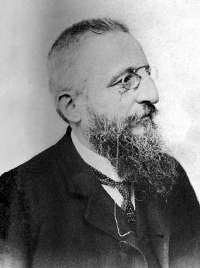Pier Andrea Saccardo (1845 - 1920) - a brief biography
The information below is derived from many sources; major reference texts are listed at the foot of the page.
Born in Volpago del Montello, Treviso, in northern Italy, on 23rd April 1845, Pier Andrea Saccardo was interested in nature, and botany in particular, from an early age. During his early years, in the village of Selva del Montello (even today its population is little more than 1500 people) Saccardo began his plant collection, and in 1864, at the age of only 19, he published Flora Montellica: an introduction to the flora Trevigiana.
Saccardo studied in Treviso, in Venice and finally in Padua University, graduating in 1867 and receiving a doctorate in 1869. Four years later he published Mycologiae Venetae Specimen, in which he described some 1200 fungi species, including 52 that were new to science. He later extended his coverage to include all regions of Italy and eventually to all fungi worldwide - an over-ambitious task, but one into which, through persistence, methodical working and great attention to detail, he made amazing inroads over a period of about 35 years. In 1876 Saccardo established the Michelia, a mycological journal in which many of his early papers were published. Three years later he acquired a chair in Botany at the University of Padua, where he was also director of the university's botanical gardens. At this point he began work on his nine-volume Sylloge Fungorum husque cognitorum omnium (1882-1990), for which he has been called the Linnaeus of fungi.
Saccardo's research interests were focused on fungi, and he was particularly intrigued by the asexual fungi (the so-called fungi imperfecti or deuteromycetes), for which he devised a - Classification system based upon spore colour and morphology. His main published work was Sylloge, which listed all of the scientific names that had been used for fungi. Running to 160,000 pages and covering about 70,000 species, the final volume of this massive undertaking, in which Saccardo's son Daniel was one of the collaborators along with fellow mycologists Augusto Napoleone Berlese, Paul Sydow and Giovanni Battista de Toni.
Pier Andrea Saccardo died in Padua, Italy, on 12th February 1920 at the age of 75.
The abbreviation Sacc. is used to indicate Pier Andrea Saccardo as the author when citing a botanical or mycological name.
Other Positions and Awards
Professor of Botany and director of the botanical gardens, University of Padua.
Major Mycological Works
Sylloge fungorum omnium hucusque cognitorum; 1882–1890 (initially in nine volumes but extended in future editions so that by 1931 it comprised 25 volumes.
Michelia Commentarium Mycologicum V2, (P A Saccardo Ed.),1882.
History of Italian flora; 1909.
Selected Sources:
Davis, J. J. (August 1920) Pier Andrea Saccardo, Botanical Gazette 70(2): pp 156–157.
Botanical museum - Pier Andrea Saccardo’s Mycological Herbarium, at www.ortobotanico.unipd.it
Pier Andrea Saccardo (1845 - 1920), at www.comune.volpago-del-montello.tv.it
Fascinated by Fungi, 2nd Edition, Pat O'Reilly 2016, reprinted by Coch-y-bonddu Books in 2022.
Fascinated by Fungi. Back by popular demand, Pat O'Reilly's best-selling 450-page hardback book is available now. The latest second edition was republished with a sparkling new cover design in September 2022 by Coch-y-Bonddu Books. Full details and copies are available from the publisher's online bookshop...

